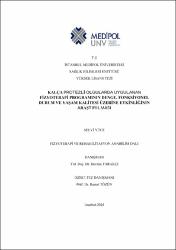| dc.contributor.advisor | Tarakçı, Devrim | |
| dc.contributor.advisor | Tözün, Remzi | |
| dc.contributor.author | Yüce, Selvi | |
| dc.date.accessioned | 2021-05-26T08:37:26Z | |
| dc.date.available | 2021-05-26T08:37:26Z | |
| dc.date.issued | 2016 | en_US |
| dc.date.submitted | 2016-01-21 | |
| dc.identifier.citation | Yüce, S. (2016). Kalça protezi yapılan olgularda uygulanan fizyoterapi programının denge, fonksiyonel durum ve yaşam kalitesi üzerine etkinliğinin araştırılması. (Yayınlanmamış yüksek lisans tezi). İstanbul Medipol Üniversitesi Sağlık Bilimleri Enstitüsü, İstanbul. | en_US |
| dc.identifier.uri | https://hdl.handle.net/20.500.12511/6931 | |
| dc.description.abstract | Total Kalça Protezi Yapılan Olgularda Uygulanan Fizyoterapi Programının Denge, Fonksiyonel Durum ve Yaşam Kalitesi Üzerine Etkinliğinin Araştırılması. Çalışmamızın amacı, Total Kalça Artroplastisi (TKA) geçiren olgulara uygulanan fizyoterapi programının denge, fonksiyonel durum ve yaşam kalitesi üzerine etkinliğini değerlendirmektir. TKA geçiren 30 gönüllü olgu çalışmaya dahil edildi. Çalışmaya alınma kriterlerine uyan hastalar ameliyattan 1 hafta önce(1.değerlendirme), ameliyattan sonra 6.Haftada(2.değerlendirme) ve ameliyattan sonra 3.ayda (3.değerlendirme) değerlendirmeye alındı. Değerelendirmelerde; Harris Kalça Skoru (HKS), Western Ontario & McMaster Universities Osteoarthritis Index (WOMAC), Nottingham Sağlık Profili (NSP), 40 metre yürüme testi ve 30 sn sandalyeden otur kalk testi kullanıldı. Gözler açık tek ayak üzerinde durma testi ve postüral denge ve düşme riski statik postürografi cihazı ile değerlendirildi. Ameliyat sonrası 6 hafta haftada 3 gün fizyoterapist eşliğinde fizyoterapiye alındı. Hastalar 6. haftadan 3.aya kadar egzersizlerine ev programı şeklinde devam ettiler. Çalışmanın veri analizinde ''Statistical Package for Social Sciences'' (SPSS) Version 20.0 (SPSS inc., Chicago, IL, ABD) istatistik programı kullanıldı.Tüm analizlerde p<0,05 (iki yönlü) değerler istatistiksel olarak anlamlı kabul edildi. 1.-2. değerlendirme, 2.-3. değerlendirme ve 1.-3. değerlendirme arasında WOMAC ve HKS skourunda, tek ayak üzerinde durma süresinde, 40 metre yürüme süresinde, 30 sn oturup kalkma sayısında, NSP fiziksel yeterlilik istatistiksel olarak anlamlı düzelme görüldü (p<0.05). Postürografi cihazi ile düşme riskinde tüm değerlendirmelerde istatistiksel olarak anlamlı fark bulunmadı (p>0.05). Çalışmanın sonucunda, Kalça Artroplastisi sonucunda uygulanan fizyoterapi programının fonksiyonel durum ve yaşam kalitesi üzerine etkili olduğu görüşüne varılırken düşme riski için daha uzun takip ve değerlendirmeye ihtiyaç olduğu fikrine varıldı. | en_US |
| dc.description.abstract | The purpose of the study is to research the effect of physiotheraphy programme on balance, functional status and quality of life in patients who have undergone total hip arthroplasty. 30 patients who have undergone THA participated to our study voluntarily.Patients who had required the criteria for participating to the study were taken evaluation 1 week before of surgery (1.evalution), 6 weeks after surgery (2.evalution), and 3 months after surgery (3.evalution). After being discharged from the hospital patients took physiotheraphy 3 times a week till their sixth week after surgery. From sixth week to third month patients countinued their home exercises programme at their home without physiotherapist. Harris Hip Score (HHS), Western Ontario & McMaster Universities Osteoarthritis Index (WOMAC), Nottingham Health Profile, 40 meter walking, 30 second sit to stand test, On one leg with eyes open test were used. Postural balance and falling risk was assessed static posturography machine. In the data analysis of the study, a statistical program called "Statistical Package for Social Sciences" (SPSS) Version 20.0 (SPSS inc., Chicago, IL, USA) was used. Throughout the whole analyses values with p<0,05 (two-way) were accepted as statistically significant. Between 1-2, 2-3, 1-2 assessments there was a statistically improvement in WOMAC and HHS scores, duration of standing one leg, 40 m walkin test, 30 s sit to stand test and NHP physical ability score (p<0.05). There was no significant difference in all assessments in falling risk and postural stability that is measured by posturography machine (p>0.05). There was significant difference between 1-2 assessments in right/left diagonal loads with open and cloesd eyes evaluated by posturography device (p<0.05). At the end of study, it was decided that physiotheraphy programme used for hip arthroplasty was effective on muscle strenght, range of motion, functional status and quality of life.However it was considered that risk of falling and postural control shoul be evaluated and followed in long term. | en_US |
| dc.language.iso | tur | en_US |
| dc.publisher | İstanbul Medipol Üniversitesi Sağlık Bilimleri Enstitüsü | en_US |
| dc.rights | info:eu-repo/semantics/openAccess | en_US |
| dc.subject | Denge | en_US |
| dc.subject | Düşme Riski | en_US |
| dc.subject | Fizyoterapi | en_US |
| dc.subject | Fonksiyonel Durum | en_US |
| dc.subject | Kalça Artroplastisi | en_US |
| dc.subject | Yaşam Kalitesi | en_US |
| dc.subject | Balance | en_US |
| dc.subject | Functional Status | en_US |
| dc.subject | Hip Arthroplasty | en_US |
| dc.subject | Physiotheraphy | en_US |
| dc.subject | Risk of Falling | en_US |
| dc.subject | Quality of Life | en_US |
| dc.title | Kalça protezi yapılan olgularda uygulanan fizyoterapi programının denge, fonksiyonel durum ve yaşam kalitesi üzerine etkinliğinin araştırılması | en_US |
| dc.title.alternative | Effect of physiotheraphy programme on balance, functional status and quality of life in patients who have undergone hip arthroplasty | en_US |
| dc.type | masterThesis | en_US |
| dc.department | İstanbul Medipol Üniversitesi, Sağlık Bilimleri Enstitüsü, Fizyoterapi ve Rehabilitasyon Ana Bilim Dalı | en_US |
| dc.relation.publicationcategory | Tez | en_US |


















